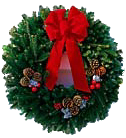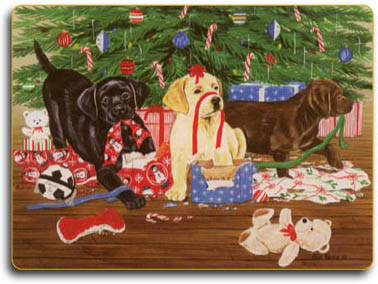


Christmas Store
The holidays are just around the corner so now is the time to fetch the finest gifts for the Labrador Lover on your Christmas list. We have over 100 gifts $50.00 and under. Visit our Christmas Store.
For the Lab
Bedding
Coats
Collars and Leads
Dog Bowls
Feeding Stations
Spa and Grooming
Toys and Treats
Travel and Accessories
For the Lab Lover
Apparel
Cards and Giftwrap
Fine Accessories
Gifts and All Occasions
Jewelry
Kids Only
For the Lab Home
Artwork
Books
Garden and Outdoor
Home Furnishings
Kitchen Accessories
Pillows, Throws, and Rugs
Gift ServicesGift Boxes
Gift Certificates
History of The Lab
The Labrador Retriever must be from Labrador, right? Not so, however. From all accounts Labs originated in Newfoundland. The name assignment may have resulted from a geographical association since Labrador is situated just northwest of Newfoundland and the sub-arctic waters of the Labrador Current flow down the east coast of insular Newfoundland. The name may also be explained by the origin of the word labrador, Portuguese for yeoman or laborer and the Spanish word for workmen, labradores. A related connection could be the village in northern Portugal called Castro Laboreiro where the dogs that guard livestock bear a striking resemblance to Labrador Retrievers.
There is a bit of mystery about the ancestors of the Labrador, appropriate perhaps given the amazing versatility of the breed. After all, how could one dog be so adept at such a wide variety of jobs, be capable of working under very harsh conditions and also have one of the friendliest personalities around? From the men who began to use the Newfoundland region for fishing in the mid to late 15th century, a rough and often seedy sort, to the aristocratic English gentlemen who refined and preserved the breed in the 19th century, the people responsible for the development of the Lab were themselves a remarkably diverse group.
The fishermen used dogs to retrieve fish that fell off hooks and to help haul in swimming lines or fishing nets. These dogs needed to be eager to please, strong swimmers and small enough to haul in and out of the two man " Dory" type boats. They needed to have short, water repellent dense coats that could withstand very cold water and wouldn't ball up with ice or bring excess water onboard. Onshore, as temporary settlements gave way to more permanent ones, a retrieving dog would have been a very useful hunting companion. The St. John's area of Newfoundland was settled predominantly by Englishmen who brought these working dogs to England through Poole Harbor, Dorset, the hub of the Newfoundland fishing trade. These St. John's dogs became the most prized sporting dogs for the gentry who could afford to maintain kennels for controlled breeding.
Without written records from the earliest days to detail which dogs came from where and to whom they were bred, we can only speculate about the ancestors of these St. John's dogs. The black St. Hubert's hound from France, working water dogs from Portugal, old European pointer breeds and dogs belonging to the native Indians have all been suggested as possible predecessors. Certainly some mixture of these or others is logical since tradesmen from around the world frequented Newfoundland for several centuries, plenty of time to develop breeds with the desired working traits. Two distinctly different breeds resulted, the larger longer haired dog used for hauling that became the Newfoundland we know today and the smaller shorter coated retriever that led to our present day labs. See the breed " standards" which detail form and function specifications for Labradors. AKC Breed Standard, FCI Standard
Some of the " Who, What, When and Where"
in Labrador Retriever History
Early 1800's - First St. John's dogs arrived in England, some imported by the 2nd Earl of Malmesbury to Heron (Hurn) Court, near Poole
1814 - First written reference to the Labrador in " Instructions to Young Sportsmen…" by Colonel Peter Hawker who observed them on Newfoundland
1823 - Sporting artist Edward Landseer painted a black dog with white markings-entitled " Cora. A Labrador Bitch."
1835 - 5th Duke of Buccleuch started kennel of St. John's dogs in Scotland
1839 - 5th Duke of Buccleuch wrote a letter referring to his " Labrador" Moss as well as the " Labrador" Drake belonging to the 10th Lord Home
1870 - the name Labrador Retriever becomes common in England
1882 - 3rd Earl of Malmesbury gave 6 of his Labs to the 6th Duke of Buccleuch and the 12th Earl of Home so that the closely held breeding stock would be preserved
1885 - Inauguration of the Newfoundland Sheep Protection Act, which imposed a duty on all dogs, along with the Quarantine Act in England and the decreasing fishing trade led to the dwindling supply of imported dogs from Newfoundland to England
1887 - Letter from the 3rd Earl of Malmesbury to 6th Duke of Buccleuch refers to the breed… " We always call mine Labrador dogs and I have kept the breed as pure as I could from the first I had from Poole….known by their having a close coat which turns the water off like oil and, above all, a tail like an otter."
1892 - Two " liver" colored Labrador pups born at Buccleuch's kennel
1899 - First yellow Lab on record, Ben of Hyde born at kennel of Major C.J. Radclyffe
1903 - Labradors recognized by the Kennel Club in England
Early 20th Century - Scottish style shooting and the prestige of bringing over a Scottish gamekeeper led to the importing of Labs to America
1916 - Labrador Club formed in England instrumental in this were Lord Knutsford (Munden Kennel line) and Lady Lorna, Countess Howe (Banchory Labradors)
1917 - First Labs registered in the American Kennel Club
1931 - The Labrador Retriever Club incorporated in the U.S. and the first American field trial for Labs held at the Glenmere Court Estate in Chester, NY
1930's - Field trial clubs spread throughout the U.S.
1933 - First American specialty for Labs held in NYC and judged by Mrs. Marshall Field
Late 1930's - Chocolates became known in 2 British kennels, Tibshelfs and Cookridge
1938 - First dog to appear on the cover of Life Magazine-" Blind of Arden" , a black Lab belonging to W. Averell Harriman. At 4 years of age he won the top US Retriever stake that year.
1941 - National Retriever Club established in the U.S.
Late 1940's and 1950's - Social and economic changes that developed after World War II led to the growing popularity of the Lab with Americans from all walks of life
1959 - First dog ever to appear on a U.S. stamp, the famous black Lab, " King Buck"
1991 - Labradors leap into first place in AKC registrations
A Lab by any other name would be as sweet…
Some of the many names used over the centuries to refer to the Lab and its ancestors:
- St. John's Dog
- Lesser St. John's Dog
- Newfoundland Dog
- Lesser Newfoundland Dog
- Little Newfoundlanders
- Newfoundland Water Dog
- Labrador Dogs
- St. John's Labrador Dogs
- Black Water Dog
- Lesser Labrador
- Smaller Labrador
- English Retriever
- English Labrador
 Can You Spot The Holiday Hazards?
Can You Spot The Holiday Hazards?It’s easy for pets, especially Labradors, to get into trouble during the holidays. You may get so busy that you lose track of what is going on with your dog.
Click here to learn more about: "Can You Spot The Holiday Hazards?"

Would you like to see your Lab pictured here? Send us images of your Lab and we may include them on our Home Page!
Labrador Links
The Verstaile Lab
History of the Lab
Advice
Travel
Featured Labs
Featured Artists
.jpg)

